11 Sep to 16 Sep, 2022 - Aktau, Kampasay, Shopak Ata, Torish, Kokala, Sherkala, Airakty, Shetpe, Tuzbair, Beket Ata, Bozzhira, Mount Bokty, Kyzylkup, Shopan Ata - (Kazakhstan)
Our well selected flight from Almaty to Aktau, in the west, was delayed. We did not receive notification of this, but I discovered it when I went to check in. So, instead of a lovely evening flight, we had another shocking middle of the night trip. Checking in, my hand luggage caused a bit of consternation. Three or four times they passed the bag through the scanner. Each time, they asked if there was a pocket knife or similar. No, I replied, knowing that I had put my pocket knife in the main luggage. Eventually, triumphantly, they pulled out a corkscrew from my bag, which I had totally forgotten about. They let me keep it, and reminded me to put it in the checked bags next time, but I am curious how it got through (twice) when we checked in and began this trip in Rome.
We had read a number of times that travelling to the west Kazakh natural sights can be difficult, and almost dangerous, if you don't know where you are going. Unsigned tracks across the steppes, around the farms, and through the camels mean that having a competent and experienced driver is a must. After twenty minutes of our three day trip, we were comfortable we had done the right thing by booking a car and guide.
Day one was the most crowded with stops. The sights were relatively close together, but the total time bouncing around was still significant. We were keen to see both the natural wonders, and the important pilgrimage cave mosques.
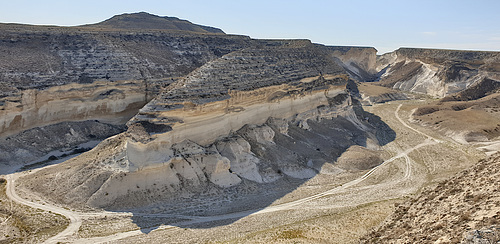
Kampasay, Mangistau region of Kazakhstan
A dusty pot-holed track across the steppe appeared to be taking us nowhere. After a while, a rift in the landscape appeared, and afforded us a view of Kampasay. Only just visible in the picture, behind the layered rock formation, there is an oasis.
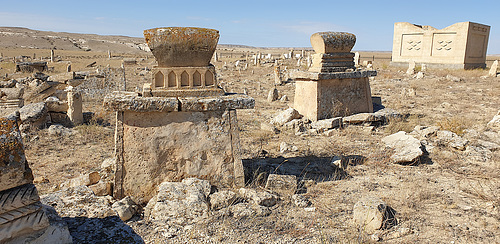
Graves Near Shokpak Ata
Shokpak Ata is a holy site in western Kazakhstan. For about a millennium, faithful have buried loved ones nearby. Some graves date from the 10th and 11th centuries, and newer ones are from the latter 1900s. Since the site is now a protected zone, new burials are no longer allowed. Only in (comparatively) recent years have dates or names been included on graves. So it is clues like style which help age the grave sites. These, we were told, are likely to be 16th or 17th century.
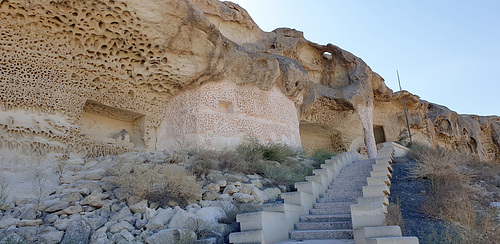
Approach to Shokpak Ata
Shokpak Ata is a cave mosque, where a Sufi monk lived and taught over 1000 years ago. Shokpak was the name given to him because of his legendary ability to create fire by snapping his fingers. Shokpak is the local word for the sound of two rocks striking a spark.
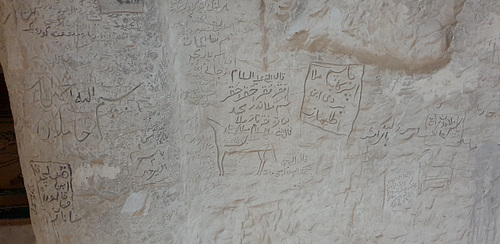
Etched Wishes and Prayers
The age of these requests are unknown, scratched in to the walls of Shokpak Ata cave mosque.
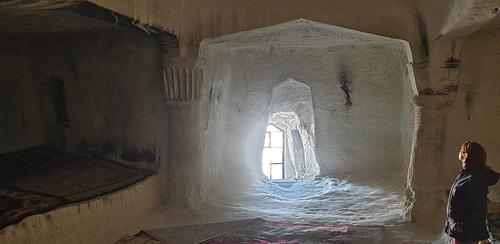
Inside Shokpak Ata in west Kazakhstan
The glass at the entrance is a twentieth century addition to protect the cave, but other than that it is just a natural cave which has been enlarged and shaped. Inside, no man made items exist other than a few beautiful hand made carpets.
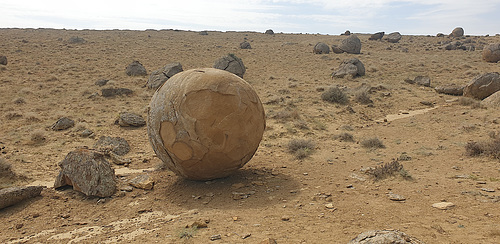
Rock Ball, Torish
We were, of course, curious about the science of these balls, which litter the landscape for a strip of a few hundred metres. The shell fossils everywhere attest that almost the entire region was once the floor of the ocean. At that time, molten lava from an underwater volcanic eruption was broken in to blobs which were rolled around on the seabed as they cooled and hardened. Apparently, here at Torish, west Kazakhstan, is one of only two places where this is known to have happened. Eggs, toirtoises, muffins - these were the descriptors we used when pointing the different rocks out to each other. Only a small number were this spherical, but these "giant's marbles" were the most engaging. Most were cracked, and many were split into parts. Millennia of freezing and heating taking its toll. Some showed layers, like rings on a tree. Others peeled a "shell" off, like a boiled egg.
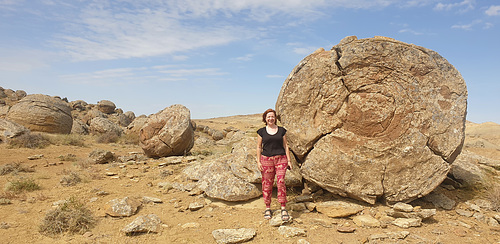
Jo, for Scale
Here, she is a prop, so you can gauge the size of the Torish rock balls. This one is split quite cleanly, and shows off some of the layering.
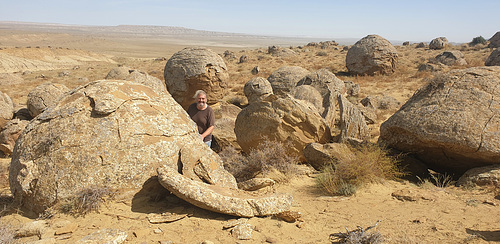
Losing Myself in the Madness
Balls, part balls, peeled off layers, and distorted shapes. It all seems to be happening.
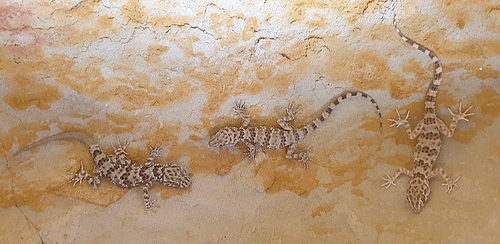
Cave Lizards
We were shown a cave, with a simple wooden door and a rug. A shelter if conditions should make it necessary to stay put. A score or more of these fat lizards were enjoying the cool conditions inside.

Kokala
According to Nur, the rate of erosion here is so high, this entire site may disappear in the next seventy years. No real rock, just layers of coloured soil. Iron rich red layers, and a brown coal seam near the top, and sulphurous gravels in between. This colourful layered mound seems so fragile.

Sherkala, the Lion's Fortress
In western Kazakhstan, Mangistau, Sherkala rises out of apparent nothingness.
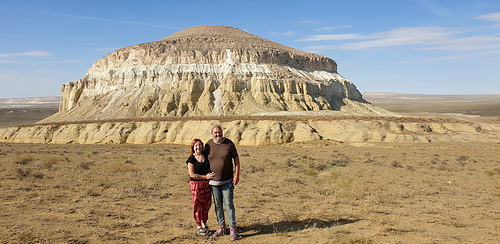
Sherkala, from Another Angle
From here it resembles a giant yurt. A popular photo spot.

Dramatic Airakty
With erosion resembling columns, this area was made famous by an exiled Ukrainian artist and poet, Taras Shevchenko. He was sent here in the 1850s after writing some prose that was unflattering to the Russian government of the day.
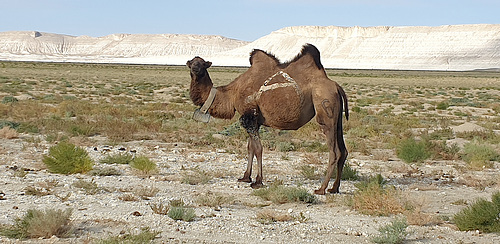
Camel
All the camels around here are marked. A letter, a number, or a symbol. By this, all know who owns which camel. We did try some proper shubat, I.e not from a plastic bottle in a supermarket. Shubat is the fermented camel's milk. It was surprisingly good, and quite refreshing.
The next two days became one little subadventure. With a magnificent night camping, one of the best camping experiences we have ever had, as the link of the two days. Fewer sights, and longer times in the car, were rewarded with wonderful vistas and stunning scenery.
Beket Ata cave mosque is a reasonable 20-30 minute walk from the car park at the top of the cliff. Winding our way down the path, we encountered hot and tired families and groups coming back up. Many smiled as we greeted them with one of our three Kazakh words. Invariably, they knew we were not local. Maybe it was our pronunciation, maybe our clothes, maybe our hair and features... Anyway, they just knew, and would frequently try and ask for information about us. Well, all we could really communicate is that we were from Australia. Oh, the smiles we would get, and even got a welcoming embrace from an older gentleman who beamed at us. Then, they would chatter amongst themselves, us not understanding a thing, except the word "Australia", and yes, almost every time, "kangaroo". At this, we would laugh, and they would laugh with us. Our confused looks ensured they knew we had only caught that small gist of the conversation.
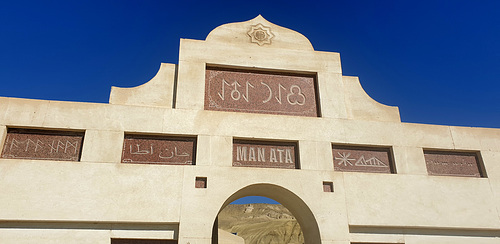
Shrine
Man Ata. Little seems to be known about the inhabitant of this grave, now a shrine, attributed with being a protector of travellers. He was a Zoroastrian teacher or priest, from before the 10th century, when Islam came to Mangistau. We have no idea what all the scripts are. But the last one had me most intrigued. The majority of vehicles seemed to stop on the way past, with the occupants spending a few minutes in prayer and meditation at Man Ata's grave.

Tuzbair, a West Kazakhstan Salt Flat
The land is dotted with depressions, many are quite a bit lower than sea level. Tuzbair is the biggest salt lake here.
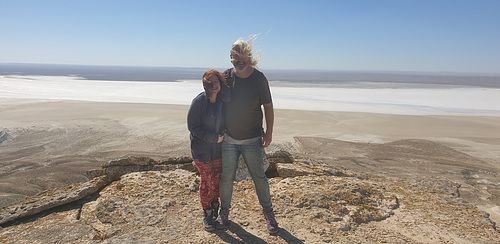
It Was Windy
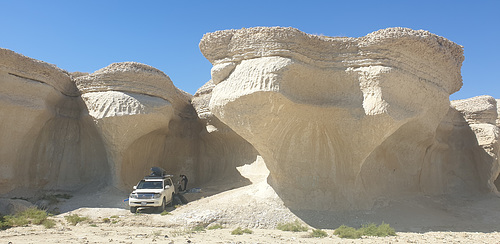
A Sheltered Picnic Spot
A place out of the wind was the number one criterion when choosing where to stop for lunch.

Holy Stick, Beket Ata
In the cave mosque of Beket Ata. Three small "rooms" where the Sufi, Beket Ata lived and taught. Pilgrims visit the cave where he is buried, and then come to this area to walk around the holy stick.
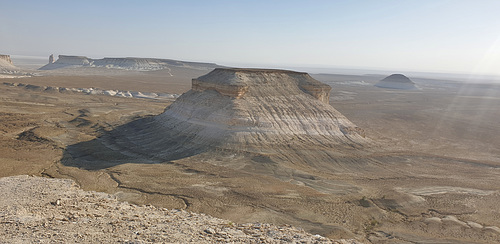
Looking Down, Bozzhira
Bozzhira in Mangistau, Kazakhstan. A multitude of gorgeous view points.
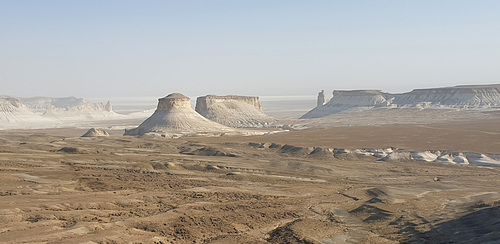
Breathtaking Views Abound
Bozzhira, Kazakhstan

I'm Running Out of Superlatives
A few kilometres from our first stop at Bozzhira. We crossed a narrow join from the surrounding plateau to an outcrop where we could absorb the splendour of this formation.

Looking Out from our Campsite
We spent the night on the floor of Bozzhira. A recess in the rockface was deemed an ideal spot for our tents, protected from the blustery gusts that seemed to build the whole afternoon.
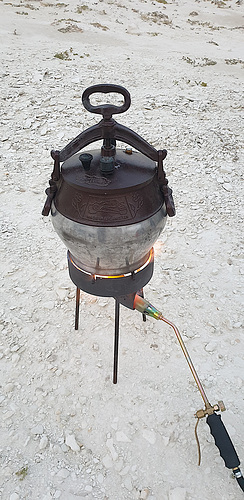
Dinner is On
Chop vegetables; add some chicken; season and spice; screw the lid on tight; heat with the nearest flame throwing device. The driver, Ruston, got this fantastic pressure cooker from Afghanistan.

Sunrise Reaches our Camp
Morning in Bozzhira, and while Ruston cooked breakfast we just spent some time appreciating the soft light striking the formations that surrounded us.
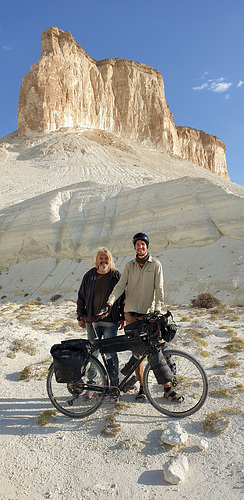
Dima, a "Keen" Cyclist
When we first saw a figure weaving through the rocks and sand and vegetation, I thought it was an animal. Despite a strong confidence in the knowledge that none would be here, I even thought it might be an ostrich. Nur said with confidence that anyone cycling here must be a foreigner, or crazy, likely both. It turned out to be a Kazakh guy, who had been riding four days, with four or five more ahead. He didn't really have a plan, or much of a map for that matter. Just wending and winding through the landscape in search of views. He appreciated greatly our gifts of water and food, and he joined us for dinner and breakfast. He cycled Jordan end to end, and once bought a bike in Amsterdam and rode to Barcelona, frequently being the first Kazakh that many Europeans had met. A toast to our crazy Kazakh Russian friend, Dima.
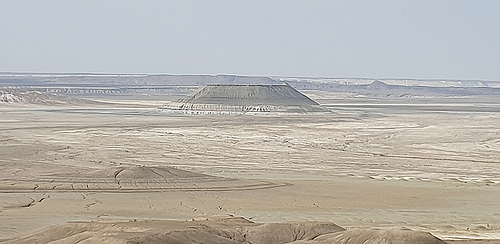
Mt Bokty
As depicted on Kazakhstan's 1000 tenge note.

Tiramisù
Jo taking in Kyzylkup, in the Kazakh region of Mangistau. For fairly obvious reasons, it is also called Tiramisù.
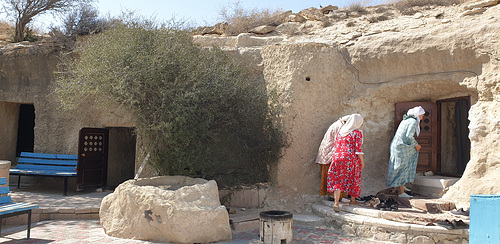
Pilgrims at Shopan Ata
Shopan Ata is the Sufi attributed with bringing Islam to the Mangistau region of Kazakhstan. Probably around the 10th century, he was teaching from this series of caves. The land near the cave mosque has centuries of burials. The closest spots are the oldest graves, with some of his students being amongst those burials. Further away, more recent cemeteries have sprung up, and burials still do occur out here, miles from everything.
No comments:
Post a Comment